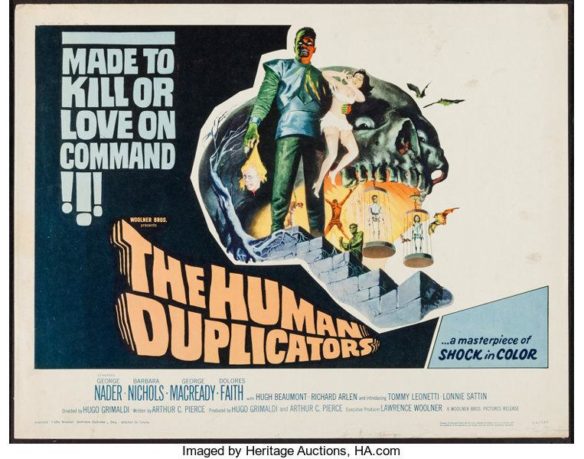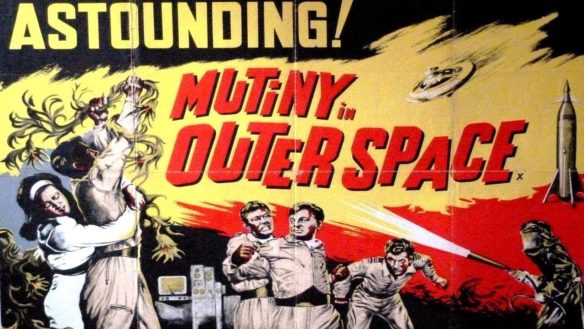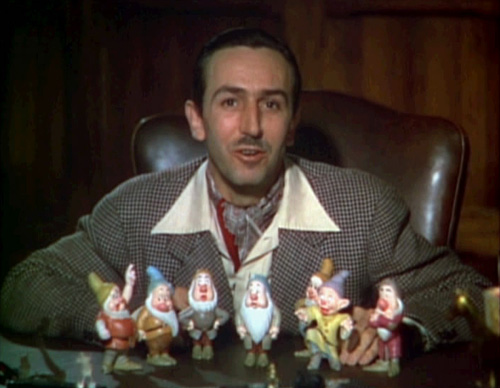(1) TERRY AND THE WIZARD. [Item by rcade.] Twitter user Edgar Allen Doe shares the tale of the day he went to Copperfield’s Books in Petaluma, California, and met the fantasy author Terry Prachett, who met a wizard. Thread starts here.
Doe writes, “I really cannot overstate the ‘full wizard regalia’ element of this person.”
Prepare to take a journey spanning six tweets that does not go the way you think it will, you jaded cynic.
One of the people who saw the tweets also witnessed the meeting, which based on a Petaluma Argus-Courier news search I did likely occurred on Oct. 15, 2006.
(2) THE HORROR. James Davis Nicoll chronicles “Five Fascinating Twists on Cosmic Horror” at Tor.com.
…Now in its seventh edition, Call of Cthulhu is the second most popular roleplaying game on Roll20. It reportedly dominates the roleplaying market in Japan. That’s interesting, because unlike most RPGs, Call of Cthulhu (or CoC for short) is set in a universe where humans are not top dog, where there are vast, incomprehensible entities who refrain from snuffing us out mainly because they’ve never noticed us, where First Contact is often Last Contact. Characters in CoC generally spend the adventure or campaign coming to grips with how out of their depth they are—before going mad. If they are very lucky, they’re eaten first….
What more do you need to cheer yourself up?
(3) THE UNKNOWN PAST. “Doctor Who’s The Timeless Children – Morbius Doctors confirmed” – Radio Times knows this is a big deal and makes sure you don’t miss it.
Doctor Who’s series 12 finale The Timeless Children dropped a number of huge reveals – but one of these twists was actually first telegraphed by the show back in 1976.
The episode revealed that the Doctor is not a native Gallifreyan, but the latest incarnation of a mysterious being called the Timeless Child, from parts unknown.
The Child or ‘Foundling’ – the first being to ever regenerate – had many different incarnations, many of which were wiped from their mind by the Time Lords (specifically by a sect of Gallifreyans called The Division).
This means that there were in fact an unknown number of incarnations of the being we now know as the Doctor before the ‘first’ (as played by William Hartnell from 1963-66).
Huge reveal, right? But this twist is not without precedent – as RadioTimes.com previously predicted, The Timeless Children has links to the 1976 Doctor Who story The Brain of Morbius, starring Tom Baker as the Doctor.
And the article goes on to glean details of the 1976 episode.
(4) WHO, RAY? “Who Is R. A. Lafferty? And Is He the Best Sci-Fi Writer Ever?” WIRED reviewer Jason Kehe does all he can to provoke us into reading The Best of R. A. Lafferty, “which Tor published earlier this year to nonexistent fanfare.”
…OK, SO A select few actually have read Lafferty, a secret society of loonies whose names you probably do recognize. Neil Gaiman. Ursula Le Guin. Samuel Delany. Other sci-fi writers, in other words. R. A. Lafferty has always been, then, a sci-fi writer’s sci-fi writer—a blurry, far-out position to find oneself in. When comedians hang out, they famously have to commit acts of borderline criminality, usually involving nudity and great heights, to get each other to bust up. So just think what absurdities a sci-fi writer has to conjure forth to gobsmack his fellow sci-fi writers—sci-fi writers who actually are, by much wider consensus, some of the best in the world.
The descriptor they tend to resort to, as if by no other choice, is sui generis, dusty old Latin for “one of a kind.” It’s probably the most common phrase associated with Lafferty (incidentally a self-taught student of Latin), and it appears not once but twice in The Best of R. A. Lafferty, which Tor published earlier this year to nonexistent fanfare and which, in keeping with the man’s self-aggrandizing sense of humor, should’ve been called The Best (of the Best) of R. A. Lafferty. Each of the 22 short stories is introduced by a writer often far more famous than Lafferty, including Gaiman and Delany, and also John Scalzi, Jeff VanderMeer, Connie Willis, and Harlan Ellison (who’s dead; his piece was originally published in 1967). Ellison—whose fellow Ellison, Ralph, wrote Invisible Man—says this of Lafferty: “He is the invisible man.” Nice….
(5) CAVEAT EMPTOR. Mad Genius Club’s Sarah A. Hoyt, in “Time has come to talk of many things”, says a fashion style in sff book covers will rebound on publishers when readers find the books don’t deliver what’s on their jackets.
I want to talk about a new trend I’ve observed in covers, and how it applies to much of the greater world out there. I.e. how the new trend in covers is just a new way that traditional publishing has come up with to screw itself and the entire field of writing over.
… If you have been alive a long time, or even if you “just” read books for a long time, you’re probably aware that there are trends in covers, as there are in everything else. In covers, though, particularly in the era of mega-chain bookstores, that “look” not only tended/tends to be more uniform, but it changes completely….
And then…. I kept running into more of these covers from other houses. Covers that explicitly try to look like they’re at the latest in the 50s.
Look, as a marketing strategy it’s brilliant. And stupid as heck.
Why?
Well, because now people are getting used to looking at Amazon for books that they remember reading/used to read/etc. they will be drawn to covers that are what they remember when they fell in love with a genre.
The problem is this: for most of the mainstream publishing, the contents won’t match the cover.
And yes, I can see them totally preening and going “if we get the rubes to look at our much superior product, they’ll love it.”
Because, you know, in the industry, it’s never about publishing what people want to read. It’s about “educating” the public. Which has taken them from 100K plus printruns for midlist to 10k printruns for high list….
(6) DR. SEUSS’ WWII POLITICAL CARTOONS. At “Dr. Seuss Went to War”, UC San Diego hosts a searchable gallery of his editorial cartoons from before and during WWII. Having discussed just yesterday the criticisms levied against his imagery of nonwhites, it’s interesting to see that some of these 1940s cartoons go after America’s leading racists of the time such as Gerald L.K. Smith.
Because of the fame of his children’s books (and because we often misunderstand these books) and because his political cartoons have remained largely unknown, we do not think of Dr. Seuss as a political cartoonist. But for two years, 1941-1943, he was the chief editorial cartoonist for the New York newspaper PM (1940-1948), and for that journal he drew over 400 editorial cartoons.
The Dr. Seuss Collection in the Mandeville Special Collections Library at the University of California, San Diego, contains the original drawings and/or newspaper clippings of all of these cartoons. This website makes these cartoons available to all internet users. The cartoons have been scanned from the original newspaper clippings in the UCSD collection.
Dr. Seuss Goes to War by historian Richard H. Minear (The New Press, 1999) reproduced some two hundred of the PM cartoons. That means that two hundred of the cartoons available here have received no airing or study since their original appearance in PM. The cartoons Dr. Seuss published in other journals are even less known; there is no mention of them in Dr. Seuss Goes to War. Dr. Seuss also drew a set of war bonds “cartoons” which appeared in many newspapers as well as in PM.
(7) MEDIA BIRTHDAYS.
[Double feature!]
- March 3, 1965 — On this day in 1965, The Human Duplicators premiered. It was produced and directed by Hugo Grimaldi and Arthur C. Pierce (without a credit for the latter as director). The film stars George Nader, Barbara Nichols, George Macready and Dolores Faith. It was the color feature on a double bill with the black-and-white Mutiny in Outer Space. It wasn’t well received by critics, and Mystery Science Theater 3000 gave it their usual treatment. It currently holds a zero percent audience rating at Rotten Tomatoes. You can see it here. (CE)

- March 3, 1965 — On this day in 1965, Mutiny in Space premiered. It was, produced, directed and written by Hugo Grimaldi and Arthur C. Pierce (although the latter was not credited as directing). It starred William Leslie, Dolores Faith, Pamela Curran and Richard Garland. The word “meh” would best sum up the reaction critics at the time had to this film. It has no rating at Rotten Tomatoes so you’ll need to watch it here and see what you think of it. (CE)

(8) TODAY’S BIRTHDAYS.
[Compiled by Cat Eldridge and John Hertz.]
- Born March 3, 1863 — Arthur Machen. His novella “The Great God Pan” published in 1890 has garnered a reputation as a classic of horror, with Stephen King describing it as “Maybe the best horror story in the English language.” His The Three Impostors; or, The Transmutations 1895 novel is considered a precursor to Lovecraft and was reprinted in paperback by Ballantine Books in the Seventies. (Died 1947.) (CE)
- Born March 3, 1920 — James Doohan. Montgomery “Scotty” Scott on Trek of course. His first genre appearance was in Outer Limits as Police Lt. Branch followed by being a SDI Agent at Gas Station in The Satan Bug film before getting the Trek gig. He filmed a Man from U.N.C.L.E.film, One of Our Spies Is Missing, in which he played Phillip Bainbridge. Doohan did nothing that I can find of a genre nature post-Trek. ISFDB notes that he did three Scotty novels co-written with S.M. Stirling. (Died 2005.) (CE)
- Born March 3, 1923 – Erik Blegvad. Illustrated more than a hundred children’s books; as ever, opinions will differ on which we can count. Apprenticed in a machine shop, left it when the Nazis took Denmark, imprisoned for distributing Danish Resistance literature, eventually translated for the British. Self-Portrait 1979. Three of Sharp’s Miss Bianca books (Miss B is a mouse); Bed-Knob and Broomstick – his cover, one of his interiors; his own translation of Hans Andersen. Washington Post appreciation here. (Died 2014) [JH]
- Born March 3, 1924 — Catherine Downs. She’s in four Fifties grade B SF films: The Phantom from 10,000 Leagues, The She Creature, The Amazing Colossal Man and Missile to the Moon. All but the first film werewas the subject of a MST3K show. (Died 1976.) (CE)
- Born March 3, 1928 – Paul Callé. (“KAL-lee”.) Known for NASA work, see this book; here is an Apollo XI drawing; see more of his Space art here. It is of course open to the rejoinder Not fiction. Here is The Legion of Space. Here is The Star Seekers. Here is an interior from the Jul 50 Super Science Stories. He did much with the American West (i.e. U.S. and Canada); see how each person is portrayed here. His pencil book here. (Died 2010) [JH]
- Born March 3, 1936 — Donald E. Morse, 85. Author of the single best book done on Holdstock, The Mythic Fantasy of Robert Holdstock: Critical Essays on the Fiction which he co-wrote according to ISFDB with Kalman Matolcsy. I see he also did two books on Kurt Vonnegut and the Anatomy of Science Fiction on the intersection between SF and society at large which sounds fascinating. (CE)
- Born March 3, 1938 – Patricia MacLachlan, age 83. A novel and four shorter stories for us; thirty other books, one winning a Newbery Medal, one about Matisse; still writing, most recently published last June. [JH]
- Born March 3, 1945 — George Miller, 76. Best known for his Mad Max franchise, The Road Warrior, Mad Max 2, Mad Max Beyond Thunderdome andFury Road. He also directed The Nightmare at 20,000 Feet segment of the Twilight Zone film, The Witches of Eastwick, Babe and 40,000 Years of Dreaming. (CE)
- Born March 3, 1955 – Greg Feeley, age 66. Two novels, thirty shorter stories for us. I keep heaing he’s turned in Hamlet the Magician, but not when we may expect it. Here is a note on Robinson, Le Guin, Clute, Egan. Here is a note on Thurber’s “Catbird Seat”. Here is “Why I Love Laurence Sterne Scholarship”. Four dozen reviews in Foundation, SF Age, and like that. Interviewed Waldrop for Interzone. Himself interviewed in Lightspeed. [JH]
- Born March 3, 1970 – John Carter Cash, age 51. Indeed the son of that Cash and that Carter. While mostly in music outside our field, he’s given us one book. Website. [JH]
- Born March 3, 1982 — Jessica Biel, 49. A number of interesting genre films including The Texas Chainsaw Massacre, Blade: Trinity, Stealth, The Illusionist, the remake of Total Recall which I confess I’ve not seen, and theanimatedSpark: A Space Tail. (CE)
- Born March 3, 1981 – Kiersten Fay, age 40. Ten novels, one shorter story, of paranormal romance with demons and vampires. She’s a USA Today best-selling author. [JH]
(9) SINCE YOU ASKED. On Drew Barrymore’s show “Stephen King Confesses He Didn’t Like The Shining Movie”. He gives his opinion at about the 1-minute mark.
(10) A CLOSE SHAVE. Amazon’s new icon got an immediate re-iteration because the old “new” made people think of Hitler’s toothbrush mustache. CNN has the story — “Amazon quietly changed its app icon after some unfavorable comparisons”.

… “We designed the new icon to spark anticipation, excitement, and joy when customers start their shopping journey on their phone, just as they do when they see our boxes on their door step,” an Amazon spokesperson said. The app icon was tweaked based on user feedback.
Only iOS users in the United Kingdom, Spain, Italy and Netherlands saw the Hitler-esque logo over the past few weeks. The updated logo rolled out worldwide for iOS users last week. Android users will see the new logo beginning this week.
(11) NAVIGATING LONELINESS. [Item by Michael Toman.] Best Wishes From a Guy Lashed to the Mast of Loneliness, Listening for So Far Silent Sirens — “Kristen Radtke Writes, and Draws, Our Loneliness” at Publishers Weekly.
When Kristen Radtke started writing about loneliness in 2016, she had no idea of what was to come. Writers are famously prescient, but who could have imagined the global pandemic of Covid-19 and the isolation it would generate? Seek You: A Journey Through American Loneliness (Pantheon, July), Radtke’s latest graphic nonfiction book, is a marvelous deep dive into that universal emotion, blending science, memoir, journalism, research, philosophy, and pop culture to explore isolation and our desire to be close to one another….
(12) HOPING TO PREDICT SOLAR WEATHER. “Origin of the Sun’s solar storms discovered in scientific breakthrough” reports Yahoo!
…In 1859, a large solar storm called the Carrington Event caused widespread issues with telegraph systems across Europe and the United States.
A repeat storm of such magnitude today could be far more devastating.
But now researchers at University College London (UCL) and George Mason University in the US believe they have located where on the Sun these particles come from, in a bid to better predict when they might strike again.
Their findings, published in Science Advances journal, indicate that the particles have the same “fingerprint” as plasma located low in the Sun’s corona, close to the middle region of the it’s atmosphere.
“In our study we have observed for the first time exactly where solar energetic particles come from on the Sun,” said co-author Dr Stephanie Yardley, from UCL….
(13) VIDEO OF THE DAY. In “Kill Your Idioms” on Vimeo, Grant Kolton takes aim at well-worn cliches.
[Thanks to Mike Kennedy, Andrew Porter, Martin Morse Wooster, Michael J. Walsh, John King Tarpinian, JJ, Dave Doering, John Hertz, Cat Eldridge, and Michael Toman for some of these stories. Title credit goes to File 770 contributing editor of the day Paul Weimer.]



